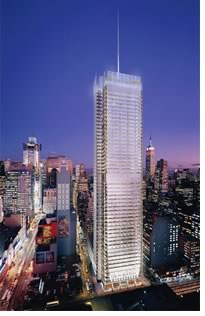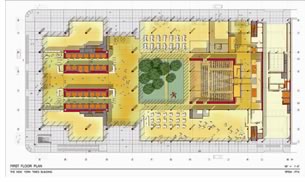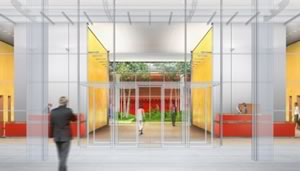

11/2005
Piano’s New York Times Building brings the garden into the workplace
 Pritzker
Prize recipient Renzo Piano’s new headquarters for the New
York Times is still under construction, but already plans are set for the
creation of a birch and moss garden at the heart of the building. Surrounded
by glass walls 70 feet high, the enclosure will contain the first moss
garden in Manhattan and include nine 40-foot-tall Paper Birch trees.
Pritzker
Prize recipient Renzo Piano’s new headquarters for the New
York Times is still under construction, but already plans are set for the
creation of a birch and moss garden at the heart of the building. Surrounded
by glass walls 70 feet high, the enclosure will contain the first moss
garden in Manhattan and include nine 40-foot-tall Paper Birch trees.
The 70-foot-square enclosure, which will share a wall with an auditorium, is to be the centerpiece of the 80,000-square-foot lobby. As workers enter and exit the building, they will walk past the garden sanctuary and delight in its appearance and adaptability as it transitions through the seasons. The cool and calming organic moss and birch garden are a delightful foil to the urban building’s bright red and yellow lobby. “The garden is the space that allows people who use the building to connect with nature,” says landscape architect Henry M. (Hank) White III.
To flesh out his concept of a courtyard at the building’s center, the architect brought on board landscape architects White and the Vancouver-based Cornelia Hahn Oberlander at the beginning of the project. The landscape architects helped determine how the garden interacts with the lobby and auditorium and were integral to the design of the planting scheme and lighting and irrigation system.
 Studying the microclimate
Studying the microclimate
White and Oberlander conducted extensive and meticulous research to determine
the types of plants that could best inhabit the space. They studied
the site’s microclimate as well as the growing conditions within
an eight-block radius of the building. Because the Times building is
not yet complete, studying the microclimate required using 3D modeling
and a simulation program that measures light and wind and forecasts
growing conditions. Measurements of shadow angles and lengths were
taken and recorded and compared with Piano’s digital model. White
and Oberlander then created five daily simulations of the sunlight
the garden would receive throughout the year.
Drawing on that research, the team designed an irregular planting pattern for the birch trees in the northwestern portion of the garden, with rolling moss covering the remaining space. White explains, “Renzo Piano first envisioned a forest inside a building. However, when we produced a map of solar and wind conditions throughout the year, we found that only the northwest corner of the garden received enough sun to sustain trees.” The adaptability and low-light requirements of moss made it ideal for the remainder of the garden.
 An escape from the urban hustle and bustle
An escape from the urban hustle and bustle
The primary components of the garden will be fern moss, which has some
height, and the low-growing hair-cap moss. Because moss and birch trees
have different moisture needs, subsurface irrigation is planned for
the trees and a grid of pop-up sprinklers will mist the moss. The misting
will occur daily from 8:45-9:15 a.m., the peak time for employees arriving
at work, briefly turning the garden into a large enclosed fountain.
Visitors and employees will be able to get a close-up view of the garden via a footbridge that traverses the length of the garden. Open to the elements throughout the year, the New York Times Building garden offers a rare place of quiet contemplation in the midst of Manhattan.
Copyright 2005 The American Institute of Architects.
All rights reserved. Home Page ![]()
![]()
 |
||
|
||